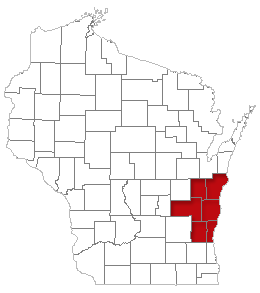The good news is that winter is half over. The bad news is that winter is only half over. Don’t leave heating to chance. Instead think “furnace maintenance” — an ounce of prevention beats a pound of cure, and a chilly wait for an expensive repairman. Here are a few things that’ll help. First change the filter. During heating season, do this monthly and — to save money — don’t buy them one at a time. Buy a whole case, and save money two ways — on the price and on your energy bills. A furnace heats more efficiently and runs less with clean filters that are changed often. Other mid-winter furnace tips? Check your owner’s manual for proper guidance. Turn off the power, vacuum the blower compartment, check tension and condition of the blower fan belt and lubricate fan-motor oil ports with a few drops of lightweight electric motor oil (do not over-oil or use automotive oil — both practices are bad). A little mid-winter furnace maintenance gives a lot of peace of mind.
Home Maintenance Tasks You Need to Tackle in January
By Lisa Gordon
We’re not gonna lie: Taking care of home maintenance tasks isn’t going to be any easier in January than it was during the holiday bustle of December. You’ve buttoned up the house against the cold, and you’re in the dead of winter without even a glimpse of spring in sight.
Still, homes must be maintained, even in January. Why? It’s always easier and cheaper to maintain a house than to repair it—sometimes to the tune of thousands of dollars.
Since we’re all about saving you time and money, we’ve created a handy checklist of home maintenance tasks that need to be completed this month—plus tips for how to do them faster and easier, or with the help of a pro. So take a deep breath and dive into those chores. The good news? Many are inside chores, so you have no “It’s too cold!” excuses.
1. Handle holiday cleanup
Task: You’ve had the fun, and now it’s time to get rid of the evidence. Take down holiday lights and wrap them around a hanger to prevent tangling; set the oven on self-clean, then wipe the interior with a vinegar-soaked cloth; chip your Christmas tree and throw it in the compost pile, or scatter it around garden beds and shrubs for a midwinter mulching.
Shortcut: Instead of pitching holiday cards or tucking them away never to be seen again, recycle them into gift tags for next year. Find a pretty part of the card that has no writing on the back, cut it into a small square, and punch a hole in the corner.
Call in the pros: If you’ve ever considered a cleaning crew, now’s the time. Figure on paying $200 to $300 for a one-time cleaning. Ask friends who have a regular cleaning person to share the name for a one-off.
2. Protect the pipes
Task: Prevent exposed pipes from freezing as temperatures drop. A frozen pipe can crack or burst, flooding your home. If you’re planning a winter vacation, don’t forget to wrap pipes with heat tape you can control with a thermostat. And if you haven’t turned off water to outdoor spigots yet, consider yourself lucky—if they haven’t yet burst, shut off water valves and open spigots to drain existing water.
Shortcut: To thaw a frozen pipe, wrap it with a heating pad or turn a hairdryer on it.
Call in the pros: If a pipe bursts, shut off the main water valve to your home and call a plumber, which will run you anywhere from $45 to $150 an hour. If everything’s drenched, a water remediation or restoration company can perform cleanup —cart away damaged material, replace ceilings and walls, paint, and reinstall plumbing fixtures—for $23 a square foot.
3. Check for storm damage
Task: After winter storms, inspect your home’s roof, siding, gutters, and yard for wind, snow, or ice damage.
Shortcut: Instead of climbing on the roof to look for missing shingles, use binoculars to search for damage. Better yet, buy a drone that can fly over your house and spot damaged areas.
Call in the pros: A little storm damage can become a big problem if you don’t make immediate repairs. A roofing company can inspect and replace a few shingles for $95 to $127; a handyman can reattach hanging gutters for $171 to $492; and an arborist can remove cracked tree limbs and prune trees for $375 to $525.
4. Seek and destroy hidden dirt
Task: Clean those filthy places that people don’t see but you know are there. They include the range hood and grilles, refrigerator coils, tops of ceiling fans, dusty light fixtures and bulbs (make sure lights are off before dusting), and HVAC vents.
Shortcut: Let your dishwasher clean metal parts such as vent grilles and range hood filters. You can pop dirty sponges and dishrags in the dishwasher, too.
Call in the pros: This deep cleaning is above and beyond the tasks that cleaning crews normally perform. If you want a crew to do this type of cleaning, negotiate the surcharge up front.
5. Give hardware some love
A lot of hands probably touched that door handle, so go head and wipe it down.
wakila/iStock
Task: Shine and tighten doorknobs and hinges; tighten loose cabinet pulls and nobs; and level cabinet doors.
Shortcut: To clean metal hardware, wash with soapy water, then shine with a microfiber cloth dipped in vinegar or lemon juice. Brass polish will remove tarnish from solid brass hardware. Not sure it’s brass? If a magnet sticks, it’s most likely metal, not solid brass.
Call in the pros: If you’re going to take off hinges and locks, hire a handyman (those doors are heavy). Prices vary widely, and some handyman services charge $125 an hour for skilled jobs. Cleaning hardware is more tedious than skillful, so don’t pay more than $30 to $60 an hour.
6. Do a deep declutter
Task: Banish piles, clean out closets and drawers, and tackle the basement if you can stand it. Channel your inner Marie Kondo: If you haven’t touched something in a year or don’t love it, then you should toss, donate, or recycle it.
Shortcut: If you can’t face a total house declutter, do little bits over a few days. Pick one room or a corner of the room to organize. Or, every time you walk into a room, put/throw one thing away.
Call in the pros: Professional organizers take no prisoners when decluttering your home and setting up systems to keep things nice and tidy. But this tough love doesn’t come cheap. A professional organizer costs $30 to $80 an hour, and the average room takes 8 to 12 hours to organize.
7. Think green
Task: If you can’t deal with the January gloom, you can always look ahead to spring. Grab those seed, bulb, and bare-root plant catalogs, and start planning your flower and vegetable gardens. If you’re starting seeds inside, plant them about six weeks before the last frost in your area.
Shortcut: You’d be amazed by how much produce you can grow in raised-bed or container gardens. There’s no hoeing, raking, or digging. Create your own weed-free soil by mixing one-third vermiculite, one-third peat moss, and one-third varied compost.
Call in the pros: What, and miss all the fun? A professional landscape designer, who designs gardens and suggest plants, costs $50 to $100 an hour. Some garden centers will give you free design advice if you buy plants there. Also, seed catalogs often have free garden plans.
Window Shopping
Now is a time of year when thoughts turn to holiday visits, window-shopping and time spent with family and friends. But for some, winter isn’t so cheery because they’ll need to spend time at the hardware store. They’ll be buying plastic film, duct tape and stick-on weather-stripping instead of having fun. While others wrap packages and relax with friends, these folks are spending needless time and money patching chilly air leaks in old windows. It’s time for “window shopping” for beauty, comfort and savings. Sounds expensive? Maybe those drafty old dinosaur windows don’t need total replacement. Lots of windows still have good frames, and all they need are new high-tech sashes installed. Why let Jack Frost and Old Man Winter ruin one more year? Check out today’s new inexpensive replacement windows. Can you afford not to?
Stripping – Like a Pro
Gypsy Rose Lee was born on this day in 1914. She turned “taking it off” into an art form. If you’ve got prized furniture with a few “bumps” and dings, you don’t have to “grind” off the old surface before refinishing. Like Gypsy, you will find stripping works best. It’s the fastest and easiest way to reveal the bare surface. And you’ll get plenty of applause when you’re done. The most powerful paint strippers contain methylene chloride. It works fast, usually within 15 minutes, but requires great care in it’s use. Apply it outdoors or with ample ventilation, and wear a respirator with safety goggles and rubber gloves. Cover the floor with newspaper, not plastic. There are also nontoxic water-based strippers that work more slowly and safely. Either way, pat on a thick coat with a brush and scrape it off when it softens. With curves, crevices and filigrees, get creative with small brushes and steel wool. When you are through, you will have a bare beauty ready for a shiny new coat of whatever.
Storm-Door Tune-up
Got a storm door that keeps slamming shut instead of closing smoothly and quietly? It started doing that just about the time cold weather set in. Right? When you took out your summer screens and put in storm-door windows, you didn’t think about the weight difference. Glass weighs a lot more than screen, and that extra weight is going to cause your door to slam shut unless you tune things up a mite. That pee-nu-matic tube way up near the top is called a ?door closer.? On the end is a small screw. Turn it clockwise. Your door will close slower, and won’t slam shut. Next spring, when it’s time for screens again, turn it counterclockwise so it closes a bit faster with the lighter weight. While the screens are out, see if they need fixing. Tomorrow we’ll tell you how to rescreen them so they’re tighter than a pair of wet leather chaps drying by the campfire.
Smart Thermostats
Bell Labs invented the first transistor in 1947. It won the Nobel Prize and paved the way for today’s many wonders. One is the smart thermostat, a full-time brain that monitors home heating and cooling, raising it when you’re there and lowering it when you are out or at night, when you’re sleeping. It keeps temperatures within one degree of what you set. Even in mild climates, programmable thermostats save money and have a short payback period. There are many types available, too, with different features and prices. One called “five-two” lets you set five weekdays and weekends. Others have a factory pre-set button that automatically programs it for you, based on the schedule of an average family. This is great for those whose VCRs still flash 12 o’clock. If you want to totally customize ups and downs, get a seven-day model and grab the owner’s manual.
Safe Social-climbing
This week a lot of folks will drag out the ladder and decorations, lights and stapler to pursue lofty goals in the ‘spirit’ of the season. To entertain family, friends and passersby, those who perform this annual ritual often start ‘social-climbing’.” Carelessness can lead to another annual event — a trip to the emergency room. This unscheduled hospital call can be avoided by using ladders properly and moving carefully when off the ground. When using a stepladder, be sure legs are fully extended and hinges are locked into place. Be sure that feet are firmly planted on solid, level ground. Heed the warning on top that says, ‘this is not a step.? It isn’t. With extension ladders set the bottom out one-fourth the ladder’s height from the wall. Make sure feet have firm support and, with both types, keep hips between side rails to maintain balance. Whether inside or out, when climbing to decorate, everything should stay up, including you.
Refrigerator Temperatures
Refrigerators and freezers must operate at precise temperatures for proper food preservation, maximum energy-efficiency and to keep them from working too hard and wearing out prematurely. The recommended levels are between 37 and 40 degrees for the refrigerator compartment and zero for the freezer section. There are individual dials and settings to control each one. Just putting a thermometer in the compartments won’t always give you an accurate reading due to door openings and fans that move air for moisture control and defrosting. To test the refrigerator side, place a thermometer in a glass of water in the center and leave it for 24 hours. For the freezer side, place the thermometer between two packages of frozen food, cover with plastic wrap and leave it for 24 hours. The next day check both and adjust accordingly, allowing another 24 hours for each adjustment until your “patient” is a perfect 37 to 40 and zero.
Reduce Home Heating Costs
Depending on where you live, sometime between 4 a.m. and 7 a.m., it’s the first day of winter. And, as the temperatures plummet, your thermostat numbers head due north, generating hefty utility bills that could put you out on the street. There are, however, ways to regain control. Here’s how to cut back on money lost and to reduce your home heating cost. Surely you’ve noticed that natural gas is up 8 percent from last year. Heating oil is worse yet — about 18 percent. Electric heat is up, too. To fight back, start with the basics: Plugging air leaks and adding insulation saves as much as 20 percent. Turn down the heat — each degree saves 3 percent. Put an insulating wrap around your water heater, and cover hot-water pipes with foam tubing. Caulk and weather-strip cracks around windows and doors, and change furnace air filters.
- 1
- 2
- 3
- 4
- Next Page »






